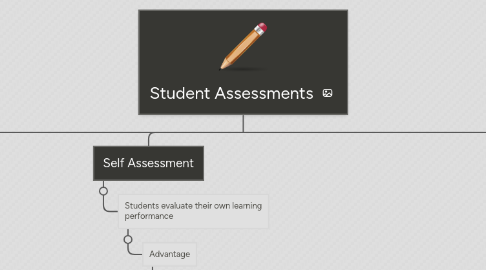
1. Diagnostic
1.1. examines what a student knows and can do prior to a learning program being implemented
1.1.1. Advantages
1.1.2. measures student understanding of content
1.1.3. Disadvantages
1.2. normally only used for Math & Reading content areas
1.2.1. Example of Diagnostic Testing:
1.2.2. First Grade beginning of the school year Guided Reading level testing
1.3. Assessment of Learning
1.3.1. Teachers use test to certify student achievement
1.3.2. Such as determining a students reading level to place them in the appropriate reading group
2. Summative
2.1. Evaluates students learning that occurred within a instructional Unit
2.1.1. Advantages
2.1.2. Formal tool used to guide/ direct students educational path
2.2. Disadvantages
2.2.1. High Stakes Assessment carrying a significant point value
2.2.2. Example:
2.3. As a final project students 1st grade students will have to create a storybook retelling the story from their closing reading unit. Such as retelling the story of the Giving Tree.
2.3.1. *Assessment of Learning
2.3.2. Used to grade students learning that occurred during a particular unit. In the case of the example above used to determine students comprehension of the story the Giving Tree
3. High Stakes
3.1. Used to make important decisions about students and school system as a whole
3.1.1. Advantage
3.1.2. Schools and teachers show their accountability for student learning
3.2. Disadvantage
3.2.1. Teachers and students become anxious over performance outcomes
3.2.2. Example
3.3. 1st grade End of Grade Reading Assement
3.3.1. *Assessment of Learning
3.3.2. Using the case above student performance outcome reflects the teachers reading instruction that occurred through the entire school. If scores are low teacher and school are held responsible.
4. Formative
4.1. Assessments occurring during instructional learning time
4.1.1. Advantages
4.1.2. students are assessed during current learning circumstances
4.2. Disadvantages
4.2.1. Work that is complete by students through these assessments to do much of a grade value.
4.2.2. Example of Formative Assessments:
4.3. 1st Grade classwork assignment students will complete a writing activity in which the have to write 2 complete students explaining the main idea of a read along with an illustration
4.3.1. *Assessment for Learning
4.3.2. Using the above as an example teacher will use the student responses from the writing assignment to determine student understanding resulting in adjustment of instruction
5. Performance based
5.1. Students demonstrate their skills and knowledge through creating their own answers for the assessment
5.1.1. Advantage
5.1.2. Students are very active during the assessment process
5.2. Disadvantage
5.2.1. More time consuming for students to complete
5.2.2. Example:
5.3. 1st Grade students will have to complete a group project in which they have act out/ role play the events of a story from recent narrative read
5.3.1. *Assessment of Learning
5.3.2. In the case of the example above teacher will use the role play assessment to determine student comprehension of story read by having student explain the story which as a result will certify student achievement of learning
6. Portfolio
6.1. Evaluation tool used for documenting student learning containing student work/artifacts
6.1.1. Advantage
6.1.2. Shows authentic student work that assesses student educational growth
6.2. Disadvantage
6.2.1. Criteria set for the portfolio must be clear and contain a steady documentation in order for the portfolio to be evaluated properly
6.2.2. Example
6.3. 1st grade student writing journal
6.3.1. Assessment for Learning
6.3.2. In the case of the example above teachers are able to use the writing journals to determine if students are meeting specific writing learning goals. For instances teachers can look through students daily writing journals and determine if the are using writing strategies and techniques learned within journals. It makes it easier to track authentic student progress.
7. Authentic Assessment
7.1. Evaluates student abilities and knowledge within real work context
7.1.1. Advantage
7.1.1.1. Focuses primarily on students analytical skills
7.1.1.1.1. Disadvantage
8. Self Assessment
8.1. Students evaluate their own learning performance
8.1.1. Advantage
8.1.1.1. Students are able to identify personal strengths and challenges
8.1.1.1.1. Disadvantage
9. Peer Assessment
9.1. Student peers grade one another's work based upon teacher guidelines
9.1.1. Advantages
9.1.1.1. Saves teacher time while also improving student understanding of teacher expectations
9.1.1.1.1. Disadvantage
